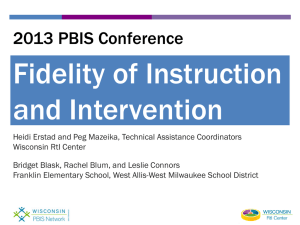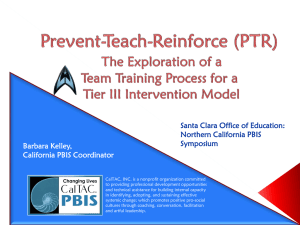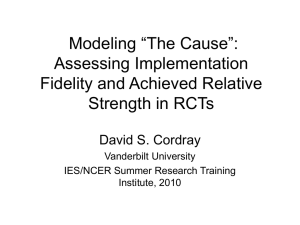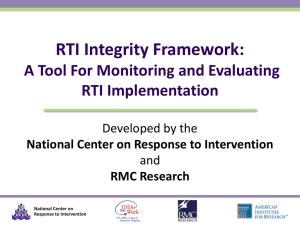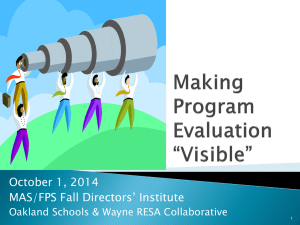Fidelity - Wisconsin RtI Center
advertisement
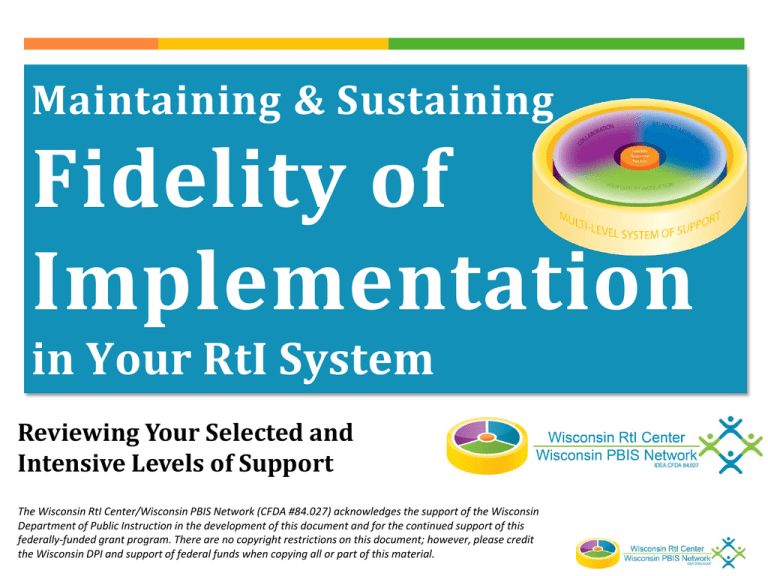
Maintaining & Sustaining Fidelity of Implementation in Your RtI System Reviewing Your Selected and Intensive Levels of Support The Wisconsin RtI Center/Wisconsin PBIS Network (CFDA #84.027) acknowledges the support of the Wisconsin Department of Public Instruction in the development of this document and for the continued support of this federally-funded grant program. There are no copyright restrictions on this document; however, please credit the Wisconsin DPI and support of federal funds when copying all or part of this material. What is fidelity of implementation? Definition: Delivery of practices in the way in which they were designed and intended to be delivered, accurately and consistently Adapted from National Center on Response to Intervention, n.d., online. Frequency, dosage, duration Modified from O’Donnell, 2008 Exposure Sticking to the plan; Using “active ingredients” Adherence Fidelity Quality of Delivery Use of “best practices” Engagement Active participation Fidelity of Implementation Teachers deliver instruction based on an established timeframe (e.g. 90 minutes a day, 5 days a week); students are in attendance Exposure Teachers differentiate content, process, and products based on student needs Adherence Fidelity in Differentiated Universal Reading Instruction Quality of Delivery Student grouping is flexible and fluid, based on data Engagement All students engaged in content, working at next level of challenge Staff implement intervention based on duration & time frame defined by program developer or research; students attend sessions Exposure Staff implement core components of interventions according to design Adherence Fidelity in Selected Level Interventions Quality of Delivery Staff deliver instruction with enthusiasm and fast pace Engagement Students are actively engaged throughout interventions Staff follow predetermined duration and frequency based on teamdeveloped individualized student plan to address student’s needs Exposure Staff adhere to individualized student plan and collect data to determine effectiveness Adherence Fidelity in Intensive Level Interventions Quality of Delivery Staff adjust instruction based on student responsiveness to plan / according to student data Engagement Student actively engaged throughout interventions working on individualized goals Staff follows established progress monitoring timeline Exposure Staff follow guidelines of the assessments Adherence Fidelity in Progress Monitoring Quality of Delivery Staff do not provide additional context or assistance to students during the assessment Engagement Students are engaged in goal-setting and track their own progress monitoring growth Data analysis teams meet within one week of screening window Exposure Predetermined measures used; Explicit written decision rules are followed to assess student, class, grade, or school-level progress Adherence Fidelity in Data-Based Decision-Making for Screening Quality of Delivery : Decisions are made in a timely way Engagement Multiple staff roles are involved in problem-solving and data-based decision-making The school leadership team meets monthly to oversee implementation of the school’s RtI Action Plan Exposure Established agendas and protocols are used consistently in leadership team meetings Adherence Fidelity in School RtI Leadership Team Quality of Delivery The team adheres to norms established by the group Engagement All team members are actively in discussions and decision-making Why is fidelity of implementation important? Where x = evidence-based practice and y = expected outcome Evidence-based assumes that a practice is being implemented as intended Cordray, 2007 Why is fidelity of implementation important? Achievement of high implementation fidelity is one of the best ways of replicating the success achieved by original research. Carroll, 2007 Why is fidelity important? High fidelity Motivated staff Increased program credibility More consistent & better student outcomes National Research Center on Learning Disabilities, 2006 What can you do to ensure fidelity? Accountability Quality control Quality assurance Support What can you do to ensure fidelity? SUPPORT Don’t skimp on professional learning! • Be clear about and build deep understanding of “active ingredients” of instruction and intervention • Over-estimate time, training, & support needed to develop fluency with new practices • Know that change occurs at the individual level; one size won’t fit all! What can you do to ensure fidelity? SUPPORT Don’t skimp on supportive structures! • Anticipate difficulties with implementation of new practices • Provide and co-create staff manuals, checklists, “calibration checks,’ and guidelines • Create feedback loops What can you do to ensure fidelity? ACCOUNTABILITY • Continued monitoring is critical to success • Create a plan to monitor implementation • Analyze data to identify possible reasons for programs not performing as expected and action plan What resources are available to help? HANDOUT Resources to Support and Measure Fidelity of Instruction and Intervention Closing Thoughts… The goal of a fidelity system is to ensure that both the school process of RTI and the practices at each level are implemented and delivered as intended so that we can create a system of success for ALL. National Research Center on Learning Disabilities, 2006 References Dunst, C. J., Trivette, C. M., McInerney, M., Holland-Coviello, R., Masiello, T., Helsel, F., & Robyak, A. (2008). Measuring training and practice fidelity in capacity-building scaling-up initiatives. CELLpapers, 3(1), 1-11. Available http://www.earlyliteracylearning.org/cellpapers/cellpapers_v3_n1.pdf. Forbus, D., Milbank C., & Hughes, J. (2011). Maximizing Student Outcomes – What does Instructional fidelity have To Do With It? EssentialEducator.org Johnson, E., Mellard, D., Fuchs, D. & McKnight, M. (2006). Responsiveness to intervention (RTI): How to do it. Lawrence, KS: National Research Center on Learning Disabilities Leonard-Barton, D. & Kraus, W. (1985). Implementing new technology. Harvard Business Review. 6, 102 – 110. Mellard, D., (2010). Fidelity of implementation within a Response to Intervention (RtI) framework: Tools for schools. National Center on Response to Intervention. National Center on RtI. (2009). Fidelity of implementation within an RtI framework. Available http://www.rti4success.org/pdf/FidelityImplementation_10-20-09_FINAL.pdf References National Research Center on Learning Disabilities. (August, 2006). RtI manual: Fidelity of implementation. Available http://www.nrcld.org North Dakota Department of Public Instruction. (n.d.). Fidelity of Implementation. Available http://www.dpi.state.nd.us/speced/personnel/fidelity.shtm Protheroe, N., (2008). The impact of fidelity of implementation in effective standards-based instruction. Principal, 38 – 42. SCRED. (2011). Implementation integrity within an RtI framework: Critical roles and tools for school psychologists. Available http://www.nasponline.org



